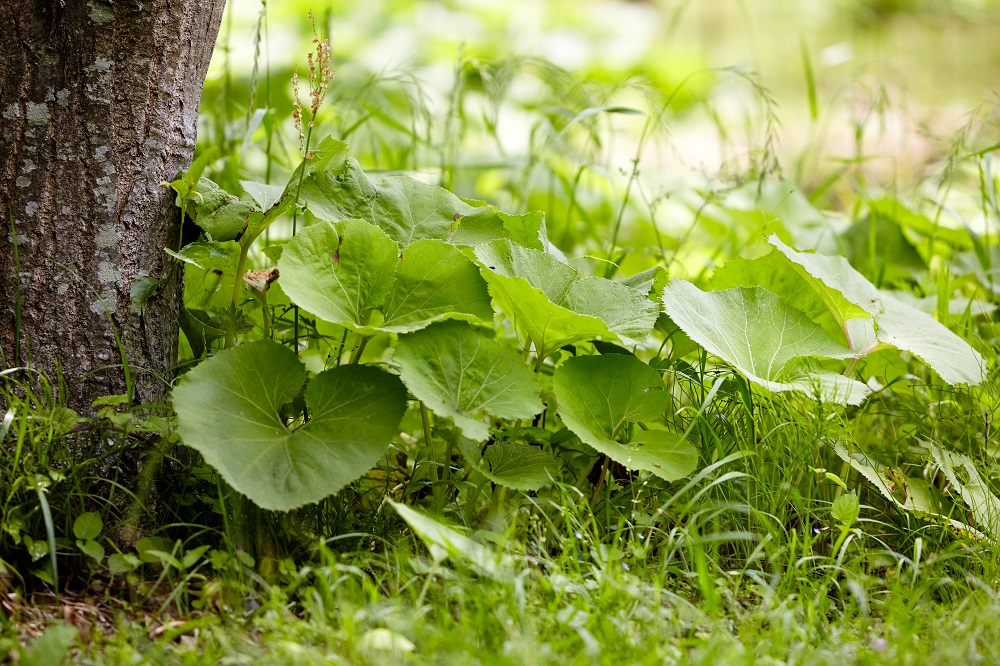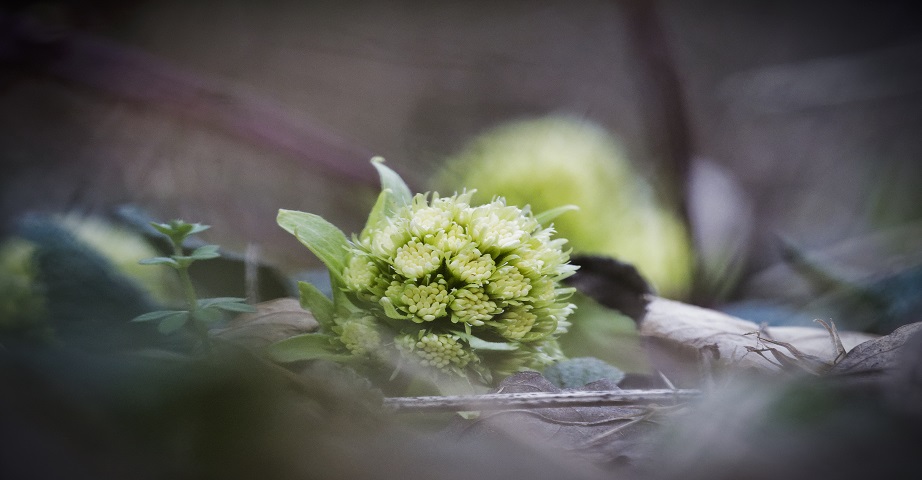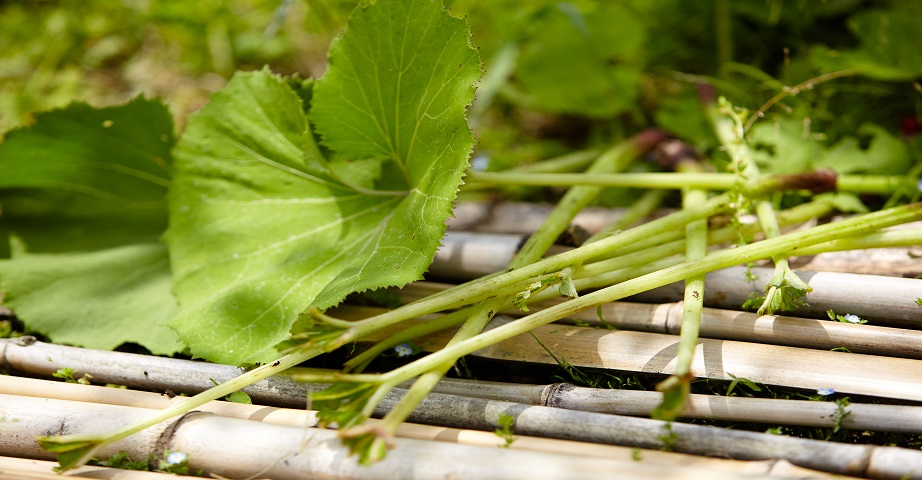Butterbur - characteristics and health-promoting properties of perennial

Butterbur is a plant from the Asteraceae family, whose characteristic feature is large leaves, growing out of the rhizome after the flowers finish blossoming. The leaves and roots of the herb have been used in natural medicine for years due to its potential health-promoting properties. What active ingredients are present in butterbur? What effect can the plant have on the human body? What are the contraindications to the use of butterbur, and is the herb safe for humans?
What is butterbur?
Butterbur is a perennial belonging to the Asteraceae family. The Latin name for butterbur, which reads "petasites", comes from the Greek word "petasos", which means a headwear with a characteristic, round brimmed, which used to protect shepherds from the sun. The name of the plant refers to its leaves, which can reach considerable sizes. Interestingly, the butterbur leaves are also responsible for the English version of the name of the plant "butterbur", which is associated with their former use - butter was wrapped in the butterbur leaves to protect them from rancidity.
The butterbur has been known and used for almost 2 thousand years. Naturally, the plant can be found in almost all of Europe, as well as in some regions of Asia and North America. Also in Poland there are some varieties of herbs - the largest amounts of plants grow on the Podkarpackie area.
The butterbur is found in a variety of environments, although it is most often found in wetlands and in intensely humid forests. The plant likes partial shade and is very characteristic - it covers the ground with a generous carpet made of large, green leaves, the diameter of which can reach up to 70 cm. The leaves of the butterbur grow on long stems and have long petioles. The leaf lamina takes a heart-kidney shape, and on the lower surface it is carried away by a dense cutter. On the sprigs of the plant evolve paniculate inflorescences collected in baskets, set at the top of a single inflorescence shoot. The butterbur flowers, depending on the variety, can take white, pink and even yellow colour. The plant quickly begins the flowering process - pronounced buds can be observed already in early spring, in mid-March. The butterbur usually forms single-species groups. Because it can interfere with the development of neighbouring plants, it is sometimes considered an invasive species.
Varieties of butterbur
The butterbur is a plant that comes in 18 different varieties. All species of the butterburs have similar properties, but they differ in the appearance of inflorescences and the place of occurrence. The species includes plants such as:
- butterbur pink (Petasites hybridus),
- butterbur white (Petasites albus),
- japanese butterbur (Petasites japonicus),
- cutter butterbur (Petasites spurius),
- butterbur bald (Petasites kablikianus).
In Europe, can be found 9 types of butterburs, while in Poland - 4 of them. Due to its health-promoting properties, the most commonly used is the pink butterbur, which, as the name suggests, is distinguished by small pink flowers, although the white butterbur, whose inflorescences are characterized by a white colour, is equally popular.
Butterbur - active ingredients
The butterbur is a plant that is appreciated in natural medicine. In perennial there are many active substances that can positively affect the human body. Biologically active compounds with pro-health potential can be found in both leaves, shoots and rhizomes of butterburs. In the composition of the butterbur there are substances such as:
- dietary fibre,
- inulin,
- flavonoids,
- tannins,
- essential oils,
- mucilages,
- minerals such as sodium, calcium or potassium.
However, active compounds isolated from butterbur root, such as petazine and isopetazine, are considered the most important. These are the main substances present in the plant that can affect the human body. They have anti-inflammatory, analgesic, spasmolytic and antihistamine properties.
Interestingly, toxic pyrrolizidine alkaloids can also be found in the tissues of the plant, which are compounds that may have a negative effect on the liver, lungs or circulatory system. In pharmacological preparations with butterbur, it is often possible to meet the designation "PA-free", which means that the product has been deprived of dangerous pyrrolizidine alkaloids.
Butterbur and folk medicine
Historical data suggest that the butterbur is a plant whose health-promoting properties have been used by humans for almost two thousand years.
In medieval times, decoction from the roots, stems and leaves of the pink butterbur was used as a remedy for plague decimating humankind, as well as for fever. The butterbur was also used as a preparation for cough, asthma or a wound cleanser. Proponents of natural medicine used the plant during urinary tract inflammation or during stomach ailments. The butterbur was also used as a specific that facilitates breathing for hay fever and chronic cough. Sometimes the butterbur rhizome was also used during a headache and as a remedy for lack of appetite. What does modern scientific research say about this?

Butterbur - properties
Scientific data suggest that the butterbur may shorten the duration of migraines and reduce their frequency. At the same time, the extract from the plant may have analgesic effects and prophylactic effects in the case of migraine headache. This is because the butterbur can reduce the production of inflammatory mediators by inhibiting the activity of cycoxygenases, lipoxygenases and phospholipase A2. In addition, the active compounds present in the plant can inhibit the release of a peptide associated with the calcitonin gene, which is activated during migraine attacks and is responsible for the contraction of blood vessels in the brain.
Thanks to the reduction of inflammation and inhibition of mast cells, the butterbur may also have anti-allergic properties. The extract from the plant can relieve rhinitis and sneezing during hay fever. The active compounds isolated from the leaves and rhizomes of the butterbur can reduce the secretion of proteins and leukotrienes, which are responsible for allergic inflammatory reactions and allergic reactions. Thus, the butterbur may contribute to lowering histamine levels and reducing undesirable respiratory symptoms.
As if that were not enough, the Japanese butterbur may have antimalarial properties. Moreover, the results of scientific research suggest that the plant may have antioxidant effects and thus may contribute to the reduction of oxidative stress and neutralization of free radicals. At the same time, it can also delay the aging process of body cells.
There are also data indicating that the butterbur may improve metabolism and contribute to the inhibition of increased triacylglycerol concentrations in plasma. The herb may also cause a decrease in pancreatic lipase activity and delay the absorption of fat in the intestines. Petazine, the active substance present in the butterbur, can modulate glucose metabolism and inhibit triglyceride accumulation, and thus can be a promising compound in the treatment of obesity and metabolic syndrome.
It is widely recognized that the butterbur can lower blood pressure, increase body sweating, show sedative properties, and can also have a protective effect on the body during inflammation of the nerves, what can be helpful in the treatment of neurodegenerative diseases. However, further scientific research is needed to confirm the possible effect of the compounds contained in the plant on diseases of the nervous system.
Use of butterbur
Butterbur is used due to its potential health-promoting properties, in particular during seasonal allergies, asthma or migraine headaches.
The plant can be used in the form of compresses, as well as in the form of powdered herb. The butterbur can also be used to prepare the infusion - crushed rhizome of the butterbur and leaves should be poured with boiling water and left to infuse for 30 minutes, and then the drink should be strained and drunk 2-3 times a day for 50 ml. From the butterbur can also be made aroma, as well as tincture, for the preparation of which you need to use fresh herb. Where can buy a plant? The butterbur can usually be found in herbal stores or in stores with dietary supplements.

Is butterbur safe for human health?
Preparations containing the butterbur are available on the market and can be used by consumers, but it is worth using only safe and well-studied pharmaceutical specifics that are free of toxic pyrrolizidine alkaloids.
Although some toxicological assessments suggest that the butterbur can be safely used by humans even in high doses, as it does not show mutagenic activity, further analyses are still needed to confirm the safety of the compound.
According to the current state of knowledge, supplying the butterbur for the body, in the form of safe preparations from trusted manufacturers in doses recommended on the product packaging, it should not contribute to the occurrence of undesirable ailments and is considered safe for humans.
Butterbur - contraindications and side effects
The use of the butterbur may contribute to the occurrence of mild side effects, such as itching of the skin, stomach disorders, headaches or fatigue. Sometimes the plant can cause allergic reactions, especially among people allergic to daisies, chrysanthemums or velvets.
There is a lack of scientific data on possible interactions of the butterbur with the drugs taken, so it is worth consulting a doctor before using the extract of the plant.
The butterbur should not be used by hypersensitive people, as well as those struggling with liver or kidney problems.

